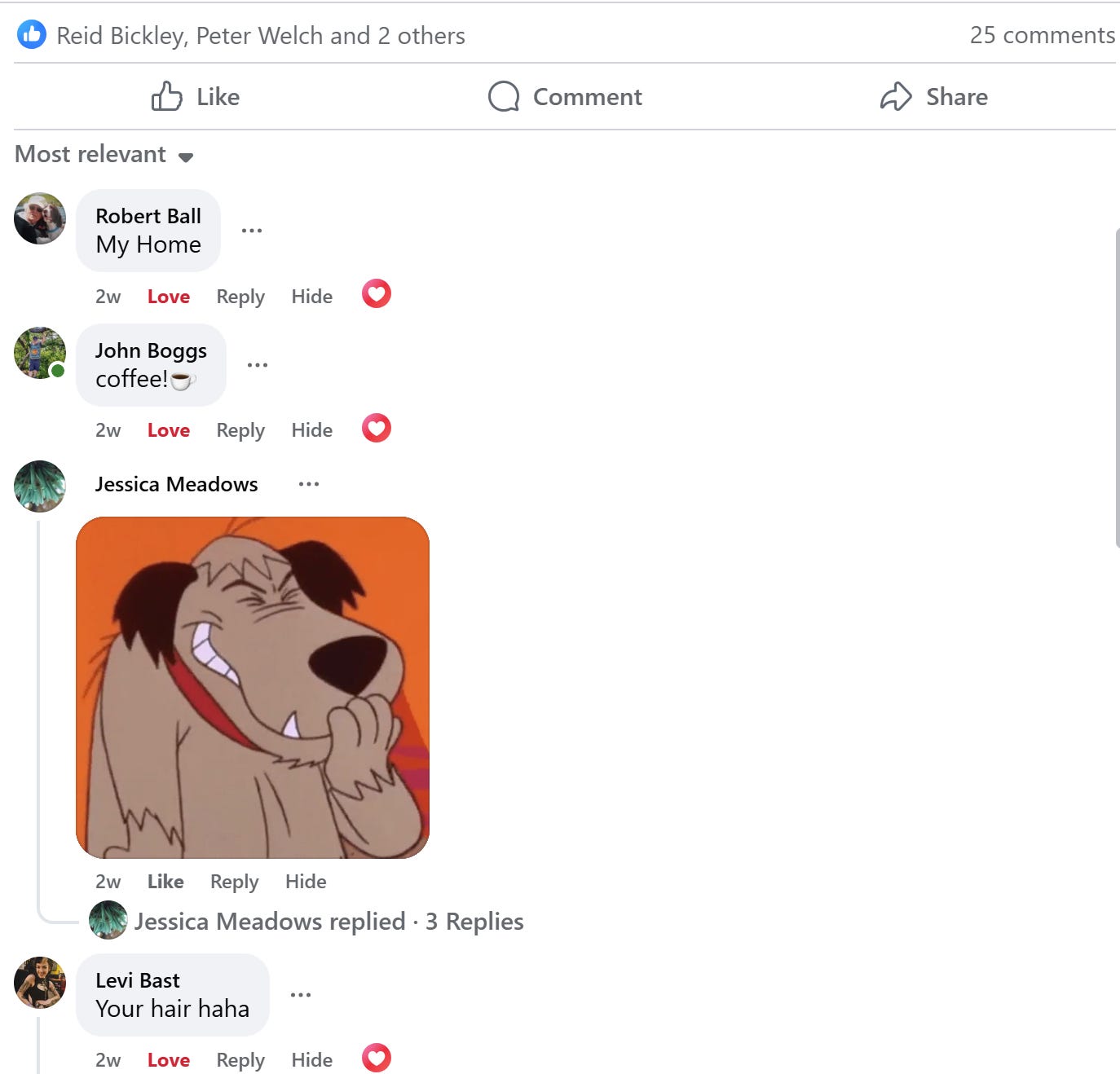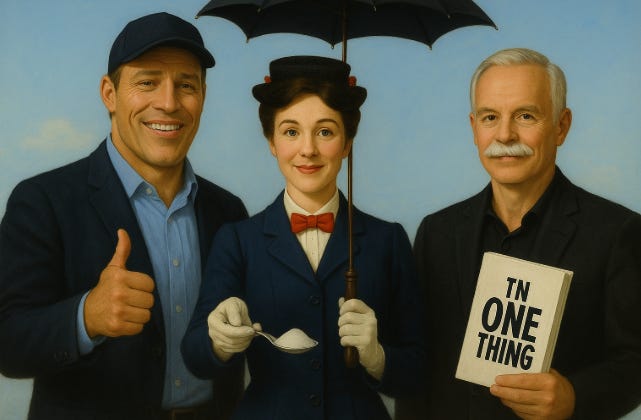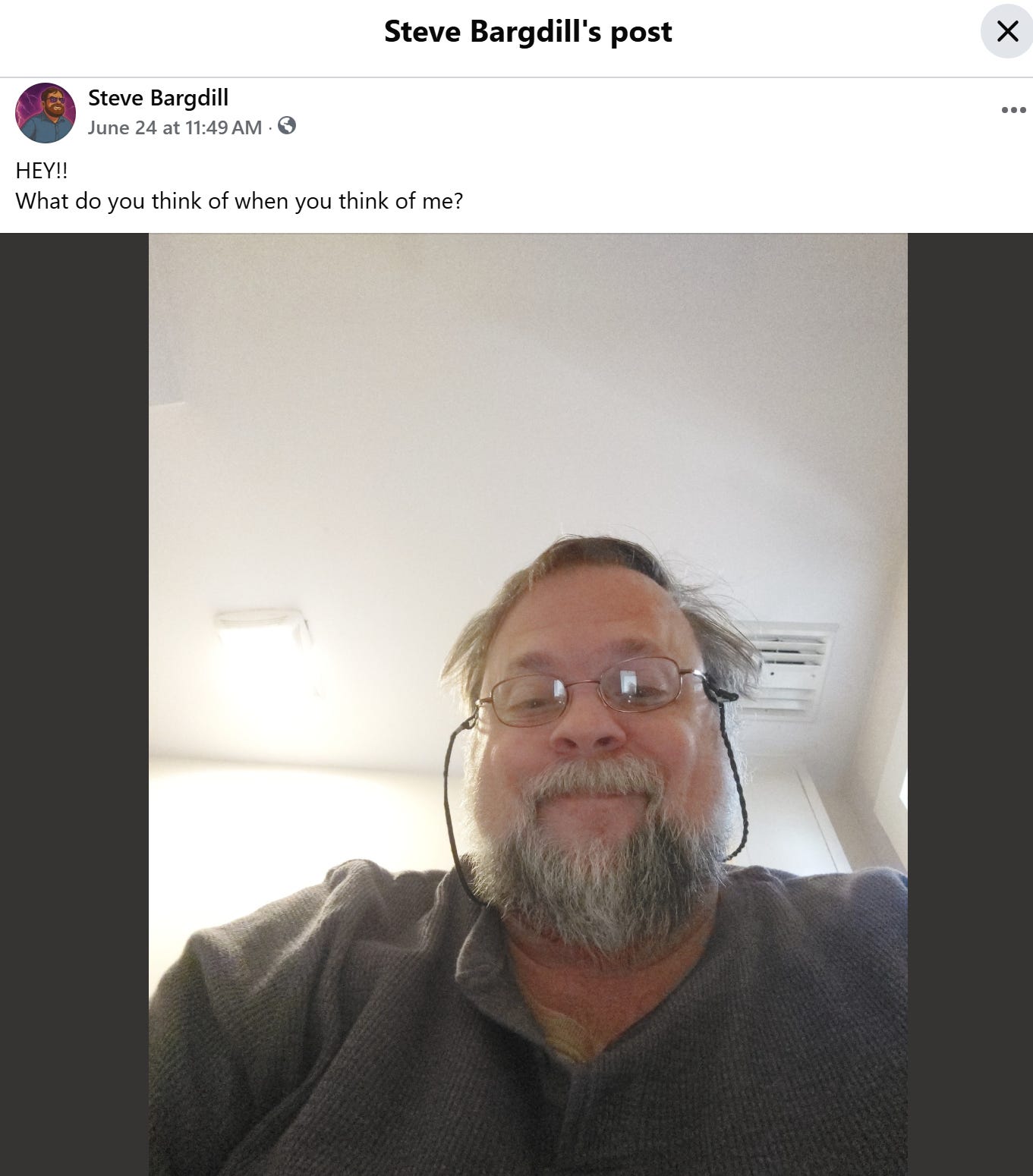The East Wind and the Lead Gen List
Tony Robbins meets Mary Poppins meets Gary Keller: how the gospel of hustle has limits. Productivity is not the same as presence.
Tomorrow marks the fifth step of the Keller Williams BOLD course, which has been freshly rewritten this year—a significant selling point, given that many Bold attendees are repeat offenders, having attended 10 to 15 times.
If you’re not familiar, Bold is supposedly an intensive, transformational training and mindset program designed to help real estate agents dramatically increase their production through accountability, sales scripts, mindset coaching, and lead generation mastery. Part sales boot-camp, part mindset reprogramming, part goal-setting accelerator.
You stand up and say affirmations. Loudly. You make phone calls during class. Real ones and in real time. If you’ve ever gotten a communication from a Realtor saying they’re in a contest and need your help to find referrals, you’ve run into a Bold attendee. You practice lead generation language patterns until they finally feel natural. Some people set a BOLD 100 challenge, where you have 100 conversations in a single day—and if you do that, you get a special pen. You write personal and business goals, and declare them in front of the group. You get your financial thermostat pushed. You’ll hear a lot of “You can have a big life!” and “You were made for more!”
Both times I’ve attended, there have been tears. All with a big dose of culty energy. Think Tony Robbins meets Mary Poppins meets Gary Keller.
If you show up and do the work, most agents walk out with deals on the table. And I will say that I personally have picked up 3 clients during Bold, but I don’t know if I would necessarily credit Bold for signing those clients.
The Bold magic sits with the 100 conversations the training asks you to have every week. By the end of the course, you should have at least 600 conversations. And sales, whether people want to admit it or not, is simply talking to people and finding out what they need. Then, solving that need for them. And personally, without Bold, on average, I manage between 75 to 100 conversations a week.
You don’t need a course to tell you to talk to more people. You don’t need a course to tell you to change your mindset to stand in front of the bathroom mirror and recite “I’m good enough, I’m smart enough, and dog gone it people like me.”
The KW machine runs on tactical optimism, productivity hacks, scripted hustle, and thinly disguised fear of nuance. Anything that can’t be laminated or monetized by Q2 gets side-eyed or dismissed.
Last week, after Bold was finished for the day, I had a bit of time to kill, so I sat in the lobby chair and doomscrolled through TikTok. Another Realtor approached me and asked what I was doing. I said, “Nothing.” And he said, “Well then, you should do something productive. Didn’t you just come out of Bold? You should be lead generating or help the managing broker move tables or… something. Cause doing nothing is doing nothing. You’re not moving forward.”
When I was sixteen, I worked at McDonald’s for a hot minute, and the manager there was a brunette brute force with giant 1980s shoulder pads in a striped shirt. She was always hollering, “If you have time to lean, you have time to clean!” But you can only wipe the same counter so many times before you’re just wiping down an already clean counter.
And listen, in grad school the mantra was If you have time to lean, you have time to read. In literary circles, it’s If you’re not writing daily, do you even want it? In real estate, it’s If you’re not lead generating, you’re losing. And the Bold gospel is Time block your entire life and tape a mirror to your phone.
They attempt to be somehow mystically logical. And new this year, they’ve come up with some magical terms: misogi, kintsugi, love is always the answer (a John Lennon riff), and the most kitschy Yoda’s Do or do not. There is no try. Be a Jedi.
Somehow, real estate, if you do it right, should transcend.
This is the same bullshit they tried to cram down my throat when I was taking the required pedagogy classes so I could teach college composition. And I took the pedagogy class twice, once at the University of Wyoming, and again at the University of New Hampshire, schools 1,992 miles apart, teaching the exact same mythology: this course is personal and will radically change the lives of the students through getting in touch with their inner writer.
Except that was never any student's goal in the college comp classroom. Their goal was, oh God, I have to take English. Why do I have to take English?
Well, you’re already an expert in the language, but you have to take English so you understand how academia wants you to structure your writing; you're learning genre and style not even necessarily applicable to the rest of your life.
Transcendence does somehow seem to be the goal of Bold attendees, when their goal ought to be more transactions. There are moments in that classroom that are absolute gold.
How to put together a listing presentation, how to work an open house, how to post videos to social media. Okay, I really don’t personally need to know how to post to social media, but a lot of people do. And a lot of people are even scared to post.

So even the social media posts we do in class are designed to help you feel better about yourself. We take baby steps from a photo to a video, and see! Look at that progress you’ve made! You’ve grown not only as a business owner but as a person on your way to enlightenment.
Sigh.
This is the point in the essay where my brain explodes a little.
If the purpose of Bold is not only to grab more business but to grow as a person, to transcend, to find enlightenment, the moment the Bold instructor says you should always continuously read to not only learn but to learning to do, I am 100% on board with that. Until the moment they add, but nonfiction, not fiction, because fiction is entertainment.
Except.
Fiction is how we’ve learned for millennia—before textbooks, before TED Talks, before BOLD scripts. Fiction teaches us empathy, timing, rhythm, myth, archetype, consequence, and builds inner frameworks where nonfiction just builds, well, bullet points.
People remember stories, not sales pitches. They model themselves after characters, not coaches. If you want to change someone’s behavior? You don’t lecture. You tell a better story.
If BOLD just trusted the intelligence in the room and focused on real, grounded, tactical real estate strategy, it could be life-changing. But instead, they lard the experience up with all the rah-rah, mirror-chanting, walk-on-hot-coals energy like they’re terrified you’ll fall asleep unless they’re clapping in your face.
And the funny thing? Early on, they use story to teach.
Success is an Inside Job
One evening, a young boy hopped on his father’s lap and whispered, “Dad, we don’t spend enough time together.” The father, who dearly loved his son, knew in his heart this was true and replied, “You are right and I am so sorry. But I promise I will make it up to you. Since tomorrow is Saturday, why don’t we spend the entire day together? Just you and me!” It was a plan, and the boy went to bed that night with a smile on his face, envisioning the day, excited about the adventurous possibilities with his Pops.
The next morning the father rose earlier than usual. He wanted to make sure he could still enjoy his ritual cup of coffee with the morning paper before his son awoke, wound up and ready to go. Lost in though reading the business section, he was caught by surprise when suddenly his son pulled the newspaper down and enthusiastically shouted, “Dad, I’m up. Let’s play!”
The father, although thrilled to see his son and eager to start the day together, found himself guiltily craving just a little more time to finish his morning routine. Quickly racking his brain, he hit upon a promising idea. He grabbed his son, gave him a huge hug, and announced their first game would be to put a puzzle together, and when that was done, “we will head outside to play for the rest of the day.“
Earlier in his reading, he had seen a full page ad with a picture of the world. He quickly found it, tore it into little pieces, and spread them out on the table. He found some tape for his son and said, “I want to see how fast you can put this puzzle together.” The boy enthusiastically dove right in, while his father, confident that he had now bought some extra time, buried himself back in his paper.
Within minutes, the boy once again yanked down his father’s newspaper and proudly announced, “Dad, I’m done!” The father was astonished. For what lay in front of him-whole, intact and complete-was the picture of the world, back together as it was in the ad and not one piece out of place. In a voice mixed with parental pride and wonder, the father asked, “How on earth did you do that so fast?”
The young boy beamed. “It was easy, Dad! I couldn’t do it at first and I started to give up, it was so hard. But then I dropped a piece on the floor, and because it’s a glass-top table, when I looked up I saw that there was a picture of a man on the other side. That gave me an idea!”
“When I put the man together, the world just fell into place.”
Repeated from earlier Bold courses is the story of the young boy who wants to spend time with his dad. The father, wanting to not spend time with the kid, gives the boy a puzzle to put together, but out from the newspaper.
This allegory is read Bold after Bold, and attendees nod in affirmation, murmuring “mm” and “yes, yes” like they have just heard the Sermon on the Mount at a tent revival draped in red Keller swag.
Last week, I finished The Teller of Small Fortunes by Julie Leong.
You know what happens in the novel? Nothing. The whole book ends happily.
Julie Leong doesn’t teach a course on branding through posting feel-good-what-do-you-think-of-when-you-think-of-me Facebook posts. She tells a story about a lonely fortune teller, a stolen child, a baker, and a mule. And by the end, without scripts or affirmations, you understand what it means to belong.
Richard Powers’ The Overstory teaches real growth takes decades, generations. Sue Monk Kidd’s The Secret Life of Bees teaches that connection already exists—May, June, and August don’t talk about transcendence but they hand you honey and ask what’s hurting. Robert McLiam Wilson’s Eureka Street teaches survival in the midst of absolute chaos. The Brief Wonderous Life of Oscar Wao says you can never run away from yourself.
And when I think about real transformation, I think about Mary Poppins—not the singing Disney version, but the shadowy figure in the book who arrives with the East Wind, opens a door between worlds, and refuses to explain anything. She doesn’t need a productivity hack. She doesn’t want you to “have a big life.”
She wants you to pay attention. To mystery. To the stars inside your teacup.
And then she leaves—without asking for a testimonial.





